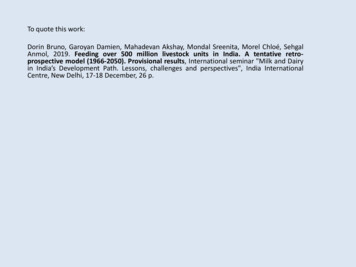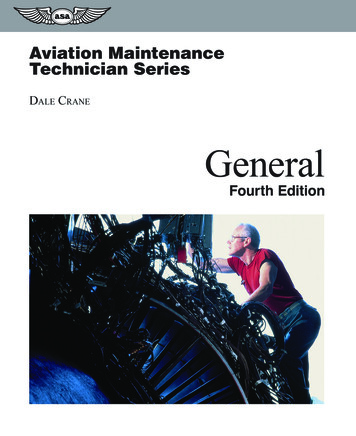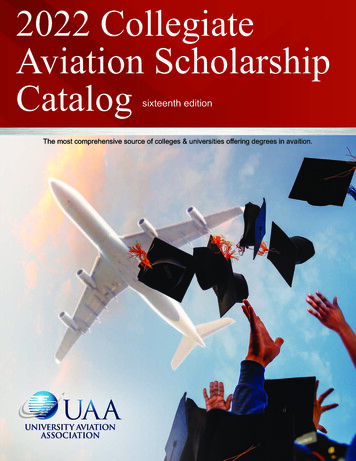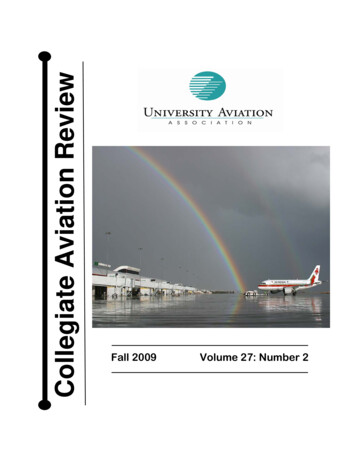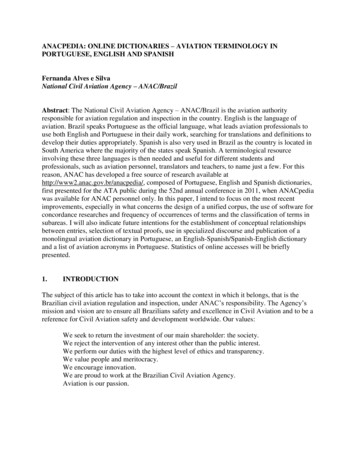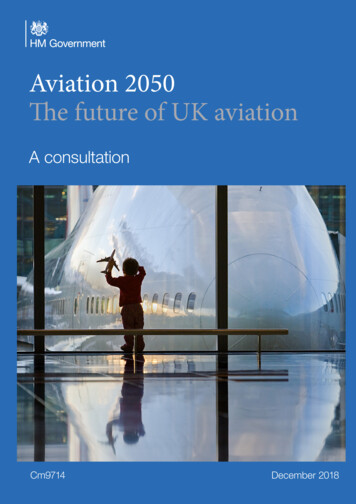
Transcription
Aviation 2050The future of UK aviationA consultationCm9714December 2018
Aviation 2050The future of UK aviationA consultationPresented to Parliament by theSecretary of State for Transportby Command of Her MajestyDecember 2018Cm 9714
The Department for Transport has actively considered the needs of blind and partially sightedpeople in accessing this document. The text will be made available in full on the Department’swebsite. The text may be freely downloaded and translated by individuals or organisationsfor conversion into other accessible formats. If you have other needs in this regard pleasecontact the Department.Department for TransportGreat Minster House33 Horseferry RoadLondon SW1P 4DRTelephone 0300 330 3000Website www.gov.uk/dftGeneral enquiries: https://forms.dft.gov.uk Crown copyright 2018This publication is licensed under the terms of the Open Government Licence v3.0 exceptwhere otherwise stated. To view this licence, visit /version/3Where we have identified any third party copyright information you will need to obtainpermission from the copyright holders concerned.This publication is available at www.gov.uk/government/publicationsAny enquiries regarding this publication should be sent to us at AviationStrategy@dft.gov.ukISBN 978-1-5286-0932-6CCS121820068812/18Printed on paper containing 75% recycled fibre content minimumPrinted in the UK by the APS Group on behalf of the Controller of Her Majesty’s Stationery Office
ContentsForeword6About this document8Executive summary121. The role of aviation in a changing world182. Build a global and connected Britain323. Ensure aviation can grow sustainably484. Support regional growth and connectivity865. Enhance the passenger experience1086. Ensure a safe and secure way to travel1327. Support General Aviation1508. Encourage innovation and new technology1669. Next steps in developing an Aviation Strategy180Annex A: Legislation to enforce the development of airspace change proposals 182Annex B: Slot allocation – the case for change188Annex C: Potential carbon abatement measures190Annex D: Proposed Public Service Obligation (PSO) assessment criteria193Annex E: Glossary195Annex F: Photo credits197
6ForewordAviation has long been at the heart of the United Kingdom’s economic success. From itsearliest days, flight has helped forge international trade links and created vital domesticconnections enabling our country to flourish.Today we have the largest aviation network in Europe and the third largest in the world, anindustry that contributes at least 22 billion to the UK economy, along with over 230,000 jobs.The industry is also growing at a rapid rate to meet rising demand. Passenger numbers havebeen increasing for seven consecutive years, and it’s estimated that UK passenger trafficcould soar from 284 million last year to 435 million by 2050.As Aviation Minister I have been hugely impressed by the sector’s ambition and innovation.In recent months we’ve seen the opening of a new terminal building at Luton Airport,the launch of new flights between Manchester and Mumbai, and Birmingham Airport’sannouncement of a 500 million expansion plan to boost capacity and improve facilities.In London and the South East our airports are nearly full, and earlier this year we supportedthe crucial Northwest runway at Heathrow after achieving an overwhelming parliamentarymajority for the Airports National Policy Statement.Clearly this growth benefits the UK. A thriving aviation sector is tangible evidence of economicconfidence, growing tourism, increased trade, and business investment. Our regional airports andthe connections, jobs and investment they provide spread these benefits across the country.As we leave the European Union, the UK’s future prosperity depends on our ability to reachout to the rest of the world, to forge new trade links, to connect and compete.However we can’t take future success for granted. The aviation sector faces globalchallenges; rising demand coupled with changing customer expectations, technologicalchange and tight profit margins in a fiercely competitive market.We need to keep asking some fundamental questions. How can we manage the impactof growth on the environment – particularly carbon emissions, air quality and noise? Howcan we continue improving the passenger experience? How can we develop a global andconnected UK with more trade opportunities? And how can we harness the benefits ofinnovation and new technology?We need a long-term plan for sustainable growth to ensure the industry’s continued success,to 2050 and beyond. That is the starting point for our new Aviation 2050 strategy.
Foreword7In developing Aviation 2050 we’ve worked closely with a wide variety of industry, communityand environmental partners, and generated a wealth of information and opinion on almostevery aspect of aviation.This consultation lays out the proposals that will form the next stage of that process as weseek to address the challenges facing the sector over the coming decades.As this consultation makes clear, the government supports aviation industry growth. Howevergrowth must be coupled with steps to mitigate environmental damage such as carbonemissions, noise and air quality. We must also minimise the impact of growth on local areasand make journeys to and from airports cleaner, smarter and quicker.As the aviation sector grows and changes, so do the needs of passengers.Airlines and airports have already carried out some impressive work on improving theexperience of passengers. However there is more work to do, particularly in the case ofpassengers with additional needs. Airports face rising numbers of requests for assistiveservices and six in ten disabled travellers say they find flying and using airports difficult.The Aviation Strategy includes proposals for a Passenger Charter – a clear set of standardsfor how airports and airlines treat consumers. These measures clearly set out the level orservice that all passengers can expect to receive at all stages of their journey, including afocus on the needs of disabled travellers. The government is examining what more it cando to improve air passengers’ journeys, for instance by introducing improvements to reducedelays at the border and dealing with disruptive passengers.This consultation paper considers a host of other issues – all of which must be tackled toensure the industry enjoys the same levels of success in future.These range from how best to seize technological opportunities so we stay at the forefront ofaerospace design and manufacture to maintaining our excellent aviation safety and securityrecord.The development of Aviation 2050 is not a process the government can undertake on its own.We need to listen to what the industry, passengers and communities have to say, and work inpartnership to get this right.This document seeks views on our proposed approach ahead of the publication of the finalAviation 2050 strategy next year.This is your opportunity to shape the future of aviation in the United Kingdom, so it works forpassengers, communities and industry.I look forward to hearing your views, and to working with you to ensure that aviation continuesto benefit our country.Baroness SuggAviation Minister
8About this documentBackgroundThe government is developing a long term Aviation Strategy to 2050 and beyond, the aim ofwhich is to achieve a safe, secure and sustainable aviation sector that meets the needs ofconsumers and of a global, outward-looking Britain.The objectives of the strategy are to: help the aviation industry work for its customers ensure a safe and secure way to travel build a global and connected Britain encourage competitive markets support growth while tackling environmental impacts develop innovation, technology and skillsThe first step in the process of developing the strategy was the publication of an initial call forevidence in July 2017 on the strategy’s aims and objectives.1 The government then publisheda ‘next steps’ document in April 2018 which set out some of the specific issues to beconsidered as part of the policy development process.2This documentStructureThis document forms part of the government’s final consultation on the policy proposals forthe Aviation Strategy. It is structured around the original objectives of the strategy, updated toreflect the feedback that the government has received to date on their relevance and priority.Each chapter relates to a strategic theme, such as ensuring aviation can grow sustainably,and contains specific policy proposals in bold text. Further detail on some of the policy issuescan be found in the annexes.1Department for Transport (2017): Beyond the horizon – the future of UK aviation. A call for evidence on anew strategy2Department for Transport (2018): Beyond the horizon – the future of UK aviation. Next steps towards anAviation Strategy
About this document9Consultation questionsThe government is seeking feedback on the policy proposals in this document and anysuggestions for additional proposals that could be considered. The objective of thisconsultation is to inform the content of the final strategy document by considering proposalsbased on their: strategic case – overall impact and effectiveness implementation – how they can be delivered and their feasibility burdens – any new or additional regulatory and financial implications overall acceptability – to passengers, the public, industry and other stakeholdersThere are seven generic consultation questions which relate to the strategic theme addressedby each chapter (chapters 2-8): These are as follows: how could the policy proposals be improved to maximise their impact and effectiveness inaddressing the issues that have been identified? how should the proposals described be prioritised, based on their importance andurgency? are you aware of any relevant additional evidence that should be taken into account? what implementation issues need to be considered and how should these beapproached? what burdens, both financial and regulatory, are likely to need to be managed and howmight those be addressed? are there any options or policy approaches that have not been included in this chapterthat should be considered for inclusion in the Aviation Strategy? looking ahead to 2050, are there any other long term challenges which need to beaddressed?Additionally, there are specific questions that relate to one or more specific policy issues atthe end of each chapter. There are also specific questions on the government’s approach toairspace modernisation and public service obligations at Annex A and Annex D respectively.
10Aviation 2050: The future of UK aviationHow to respondConsultation periodThe consultation period will run until 11 April 2019. Please ensure that your responsereaches us before the closing date. If you would like further copies of this consultationdocument, it can be found at https://www.gov.uk/dft#consultations or you can contactAviationStrategy@dft.gov.uk or telephone 0300 330 3000 if you need alternative formats(Braille, audio CD, etc).RespondingPlease use the online form at https://aviationstrategy.campaign.gov.uk to respondto this consultation. Alternatively, consultation responses can be emailed directly to:AviationStrategy@dft.gov.ukIf responding by post please send to:Aviation StrategyDepartment for Transport33 Horseferry RoadLondonSW1P 4DRWhen responding, please state whether you are responding as an individual or representingthe views of an organisation. If responding on behalf of a larger organisation, please make itclear who the organisation represents and, where applicable, how the views of members wereassembled.Consultation principlesThe consultation is being conducted in line with the government’s consultation principles.Further information is available at ationprinciples-guidanceGuidanceIf you have any comments about the consultation process please contact:Consultation Co-ordinatorDepartment for TransportZone 1/29 Great Minster House33 Horseferry RoadLondonSW1P 4DREmail: consultation@dft.gsi.gov.uk
About this document11Confidentiality and data protectionThe Department for Transport (DfT) is carrying out this consultation on a range of policiesto transform the Aviation sector in the UK. The consultation is being carried out in the publicinterest to inform the development of policy. DfT is the data controller for your personalinformation. As part of this consultation DfT is asking for your name and email address.This is in case it needs to ask you follow-up questions about any of your responses. You donot have to provide this personal information. If you do provide it, you consent to DfT using itonly for the purpose of asking follow-up questions. DfT may contract a third party to analysethe responses it receives to the consultation. If you provide your contact details, DfT mayshare this information with a contractor in case they need to contact you regarding yourconsultation response.This consultation document has been developed in collaboration with other governmentdepartments and partner agencies. Consultation responses may be shared with these otherbodies, but will not include personal details on respondents. This will aid in the facilitation offuture government policy development and legislation.You can withdraw your consent to be contacted at any time by emailing:AviationStrategy@dft.gov.ukDfT’s privacy policy has more information about your rights in relation to your personal data,how to complain and how to contact the Data Protection Officer. You can view it arterTo receive this information by telephone or post, contact us on 0300 330 3000 or write toData Protection Officer, Department for Transport, Ashdown House, Sedlescombe RoadNorth, St Leonards-on-Sea, TN37 7GA.Your personal information will be kept securely on a secure IT system within DfT anddestroyed within 12 months after the consultation has been completed.
12Executive summaryThe UK has the largest aviation network in Europe and the third largest in theworld. Aviation directly contributes at least 22 billion to the economy and supportsaround half a million jobs. The government supports the growth of aviation and thebenefits this would deliver, provided that growth takes place in a sustainable way,with actions to mitigate the environmental impacts.The UK has a rich aviation history and the government recognises the importance of aviationto the whole of the UK. Aviation creates jobs, encourages our economy to grow and connectsus with the rest of the world as a dynamic trading nation. It is also important for maintainingsocial and family ties. This is why the government supports the growth of aviation and thebenefits this would deliver, provided that growth takes place in a sustainable way, with actionsto mitigate the environmental impacts.Despite its strengths, UK aviation faces many challenges which it will need to overcome totake advantage of the opportunities the future holds, and to realise the benefits of sustainablegrowth while remaining at the forefront of innovation.
Executive summary13Challenges include: global change and shifting markets impact of competition on business models increasing passenger demand changing expectations of passengers effects of international climate change making the most of new technologyIn order to remain competitive on the global stage, and to safeguard its role as one of theleading aviation and aerospace sectors, the UK must be well positioned to take advantageof new opportunities, while managing the potential economic, political and environmentalheadwinds along the way. This is the motivation behind a new aviation strategy: Aviation 2050,which will be based around the following strategic themes.Build a global and connected BritainAviation is important for the government’s goal of building a global and connected Britain. TheUK already plays a prominent role on the world stage with the biggest international aviationnetwork in Europe and currently the third largest in the world. Through the Aviation Strategythe UK will be equipped to build new connections in rapidly growing aviation markets, and touse the leverage we have internationally to pursue our objectives on environmental measuresand liberalisation.The government is working to: improve standards globally maintain and improve the UK’s connectivity support UK aviation exports, including overcoming barriersEnsure aviation can grow sustainablyDemand for aviation has grown significantly since 2010 and the government welcomes growthin the sector, but this growth must be sustainable. Achieving this requires a partnership betweenthe government, the regulator, the industry and other interested parties to work within acomprehensive policy framework to better manage the environmental impacts of the sector.The consultation: outlines the government’s preferred approach for developing a framework for sustainablegrowth and the respective roles for the government and the industry makes the case for making the most efficient use of infrastructure, including byconsidering the system for slot allocation at airports and continuing to support theindustry in improving resilience describes the approach being taken to modernise airspace to deliver capacity andenvironmental benefits
14Aviation 2050: The future of UK aviation sets out a robust policy framework and package of measures to reduce the harmfuleffects of aviation on the environment, such as carbon emissions, air quality and noise sets out the government’s expectations that communities living close to airports shouldbenefit directly from growthSupport regional growth and connectivityAirports are vital hubs for local economies, providing connectivity, employment, and a hub forlocal transport schemes. The government wants to see, through the Aviation Strategy, thatthese benefits are maximised, by ensuring that: markets are functioning effectively for consumers and local communities airports are delivering the connectivity that regions need to maximise their potential the industry continues to provide high quality training and employment opportunities barriers to the air freight industry are reducedThe government recognises the importance of rebalancing the UK economy througheconomic growth of the regions and ensuring that the UK remains competitive after we leavethe European Union. Airports have a crucial role to play as hubs for growth within and beyondthe region in which they are situated. The government is committed to working with theindustry to develop appropriate and practical policies that support the industry’s ambitions.The Aviation Strategy consultation focuses on: regional connectivity regional transport hubs supporting freight regional employment, training and skillsEnhance the passenger experienceAll passengers should have a positive experience of flying. The industry is responsive to theneeds of consumers but improvements can be made for passengers with additional needsand when things go wrong. The government is consulting on a new Passenger Charter topromote good practice in the sector, create a shared understanding of the level of servicethat passengers should expect, and communicate roles and accountabilities clearly. Thegovernment proposes to take necessary action to improve the experience at the border andtackle problems caused by disruptive passengers. It will also consider strengthening the CivilAviation Authority’s range of enforcement powers across the consumer agenda.This Aviation Strategy consultation: sets out the proposed standards that could be included as part of a new PassengerCharter for aviation sets out a range of new measures for passengers with additional needs outlines measures to tackle the problem of disruptive passengers associated with alcohol
Executive summary15 describes the government’s approach to improving the operating model at the border toenhance the passenger experience details proposals for simplifying and improving complaints and compensation procedures sets out the government’s proposals for ensuring that consumers have timely access tothe information they need to make informed choicesEnsure a safe and secure way to travelThe UK is a global leader in aviation security and safety, with one of the best and safestaviation systems in the world. The government and the CAA share knowledge and expertisewith other nations, encouraging them to adhere to international standards and implementimprovements with the industry to make the skies safer for everyone.In order to maintain the UK’s safety record the consultation focuses on: addressing the concentration of safety risks targeting emerging safety risks improving data and reporting addressing global variations in safety standardsIn addition, through its Aviation Security Strategy, the government has committed to a majorprogramme of work in partnership with industry to get ahead of the threat to aviation.Support General AviationThe General Aviation (GA) sector covers non-scheduled civil aviation. It includes, amongstother things, business jets, pilot training, emergency service flights, air displays and aerialphotography as well as private flying. The aircrafts involved include single and multi-enginefixed wing aeroplanes, helicopters, gliders, balloons, microlights, paragliders and modelaircraft. This Aviation Strategy consultation sets out how the government proposes to enable,facilitate and encourage growth in GA, and indicates where it thinks that GA itself should seizethe initiative and capitalise on those opportunities. The consultation focuses on: how the government proposes to reduce regulation the government’s proposals for a strategic network support for new and existing commercial activities airspace safety safeguarding of aerodromes
16Aviation 2050: The future of UK aviationEncourage innovation and new technologyInnovation is key to delivering the outcomes of the Aviation Strategy. The governmentrecognises the important role that technological advances and new business models play ineconomic growth, especially in industries such as aviation and aerospace.The government wants to capture the benefits of innovation for consumers, by unlockingmobility and offering new options on how people and goods can move around; and for theaerospace and aviation sectors, to maintain the UK’s global leadership, help support jobs,increase productivity, and boost our trade and export capabilities.The consultation: sets out some of the main areas of opportunity for innovation in aviation – automation,electrification and digitalisation and data sharing identifies some of the barriers to innovation and how these can be addressed by thegovernment in its enabling role, working in partnership with the sector proposes measures to better align policy and investment
17
181. The role of aviation in a changing worldAviation has an important role to play in the future of our country. It is key tohelping to build a global Britain that reaches out to the world. It underpins thecompetitiveness and global reach of our national and our regional economies.There are many challenges that aviation faces, such as meeting rising passengerdemand while addressing environmental impacts, and making the most of newtechnologies. The government supports the growth of aviation, provided that this isdone in a sustainable way.Introduction1.1The UK has a rich aviation history, from being at the forefront of the birth of internationalair transport in the 1920s and the post-war development of the global aviationframework, to the liberalisation of aviation markets and development of innovative newtechnologies today. Aviation in the UK has consistently demonstrated the ability to adapt,innovate and lead in a changing world.1.2The government has been clear about the importance of aviation to the whole of the UK.Aviation creates jobs across the UK, encourages our economy to grow and connects uswith the rest of the world as a dynamic trading nation. It also helps maintain international,social and family ties. This is why the government supports the growth of aviation,provided that this is done in a sustainable way and balances growth with the need toaddress environmental impacts.1.3The government has, in recent years, taken action to capitalise on the UK aviationsector’s record of success and build for the future. It established the AirportsCommission to examine the scale and timing of any requirement for additional capacity,designated the Airports National Policy Statement (NPS) for airport expansion inthe South East and expressed support for a third runway at Heathrow Airport.3 Thegovernment has also consulted on plans to modernise our airspace. It has statedthat it supports airports throughout the UK making best use of their existing runways,subject to environmental issues being addressed. The government also introducednew noise policies in 2017 aimed at helping to manage the impacts of growth on localcommunities, and led the way in pushing for a historic global climate change deal forinternational aviation in 2016.43Airports Commission (2015): Final Report4ICAO Carbon Offsetting and Reduction Scheme for International Aviation
The role of aviation in a changing world1.419The government also consulted on the objectives and scope of a new and ambitiousAviation Strategy in 2017, providing a long-term vision for aviation to 2050 and beyond.This strategy must be based on a clear understanding of international and domesticaviation. It is therefore important to understand the global trends that will set the contextfor what the world will look like in 2050 and the social and economic forces that willshape the future of aviation.Figure 1 UK aviation in contextSource: Department for Transport analysis of Civil Aviation Authority (2017): Airport Data, HMRC: Overseas Trade Data 2017
20Aviation 2050: The future of UK aviationThe value of aviationAir travel benefits our lives and opens us up to the world1.5Air travel benefits most of us, either directly or indirectly. For many people, it is themeans by which they can enjoy a well-earned holiday. It is important for maintainingsocial and family ties with loved ones who may be based across the world. Business airtravel also brings trade and investment to the UK, generating prosperity.Figure 2 Passenger reasons for travel at selected UK airportsSource: Department for Transport analysis of Civil Aviation Authority: Departing Passenger Survey 20171.6Aviation is also an increasingly important facilitator of our modern lifestyles and themeans by which many of the goods that we buy online are flown in to the country beforearriving at our doorsteps, as well as the medicines and other vital products that we relyupon. Aviation is, in its own right, a passion that is enjoyed by many. It is also an industrythat is at the cutting edge of the development of new and exciting technology, fromdrones to electric planes and to the edges of space itself.1.7Aviation is also vital to how the UK is connected to the global economy. The UK’saviation network is connected to a vast number of international locations accessiblethrough airports across the country. This helps to maintain important social and culturallinks and is vital for facilitating an environment for businesses to engage in internationalopportunities.Economic contribution1.8Aviation forms an important part of the global supply chain, the means by which manybusinesses are able to operate, export and grow. An effective transport system is animportant enabler of sustained economic success, with benefits for the wider economy.
The role of aviation in a changing world21Connectivity: the UK is one of the best connected countries in the world with over 370 directconnections in over 100 countriesProductivity: aviation directly contributes at least 22 billion to the UK economy each year5 – witharound 14 billion from air transport and 8 billion from aerospace, with the UKhaving the second largest aerospace industry in the world the industries most associated with business travellers generate some of the largestcontribution to the UK economy due to the high value of the industries they tend towork in6Jobs: aviation is estimated to directly provide over 230,000 jobs and consists of around4,500 businesses;7 this generates employment right across the country, especially inaircraft manufacture, aircraft maintenance and air freight the North West and South West each account for 12% of direct jobs provided byaviation and there are large concentrations of aviation businesses in the Midlands,Wales and Scotland8 airports themselves continue to be a major source of local employment and help toattract related industries in their area, generating employment beyond the proximityof other local industry and businessesTourism: there was both a record number of visits to the UK in 2017 and a record number ofvisits abroad by UK residents; the most frequent reason for visits to and from the UKis holidays9 tourism contributed 68 billion to the UK economy in 201610 inbound tourism by air makes up 80% of foreign holiday spending115Department for Transport analysis of Office for National Statistics: GDP low level aggregates6Department for Transport (2018): Business passengers, dynamic surveying for aviation7Department for Transport analysis of Office for National Statistics: Annual Business Survey (2017)8Department for Transport analysis of Office for National Statistics: Annual Business Survey (2015)9Office for National Statistics: Travel Trends 201710 Office for National Statistics: The UK Tourism Satellite Account (UK-TSA) 201611 Office for National Statistics: Travel trends estimates, Overseas visits to the UK 2017
(Braille, audio CD, etc). Responding Please use the online form at https://aviationstrategy.campaign.gov.uk to respond to this consultation. Alternatively, consultation responses can be emailed directly to: AviationStrategy@dft.gov.uk If responding by post please send to: Aviation Strategy Department for Transport 33 Horseferry Road London SW1P 4DR


